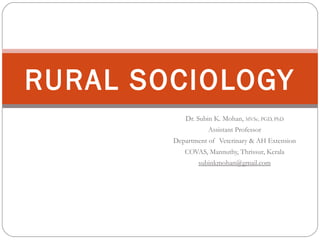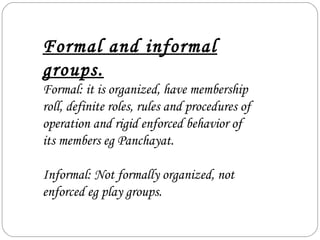- 1. Dr. Subin K. Mohan, MVSc, PGD, PhD
Assistant Professor
Department of Veterinary & AH Extension
COVAS, Mannuthy, Thrissur, Kerala
subinkmohan@gmail.com
RURAL SOCIOLOGY
- 2. Auguste Compte: Latin words- Sociotus and
logos
Sociology: Scientific study of human behaviour in relation with
other individuals and groups he interacts
Rural sociology: scientific study of social, cultural and economic
problems of rural aggregates.
- 3. Misconceptions
It’s a science not philosophy
It’s a science not socialism
It’s a science not social reform/ welfare
Science derived not based on general impressions but on pure
research
- 4. Importance
Understand humans and own social nature
Understand human affections and actions
Studies man and its institutions
Rural behaviour
Eliminates tragedies and emotions
Diagnose rural and social evils
Emphasis growth and change of society
Appraises happenings of society
Interprets the role in community development
- 5. Scope: To understand…
Social class
Caste
Religious believes
Social and economic background of rural people
Involvement of formal and informal groups
Differentiate rural and urban people
- 6. Characteristics of rural society
Village is the unit
Caste is the dominant institution
People lives traditionally
Caste occupation dominates
Cooperative function of several caste exists
Village is a self sufficient economic unit
Governed by religious/local traditions
Leisurely attitude towards life
Low standard of living
Its character and structure depends on caste religion and linguistic composition
- 7. Society
Community
Neighborhood
Family
- 8. Physical structure of Society
- 9. It refers to tangible entities in rural society
i.e. different patterns of settlement,
special distribution of houses, available
resources and the number, density and
composition of rural people themselves.
- 10. Patterns of rural
settlement
isolated farm stead- individual lives on
his farm with his farm surrounding him.
> Villages – Here dwelling of rural people
concentrated together with their
farmland. The number of dwelling
indicates size of the village.
- 11. Line villages – houses are located along a road or river etc, this forms the
shape of a line as the houses concentrate on the both sides. Their farm land
extend away from the road.eg Kuttanad
Round villages – Houses concentrated in circles.
Crossroads and market center settlements – predominately inhabited by
merchants. Normally these centers consist of shops.
- 12. Hamlets –Small villages
located away from
large villages or on
the fingers of large
villages.
Others- Just like villages
around a religious
place.
- 13. Family
Defined as a group in which sex relationship
sufficiently precise and endure to provide for
the rearing and bearing of children.
- 14. Classification
a) According to blood relations living together
> Nuclear family- Father, mother, children.
> Joint family- here a number of generations may
live together.
b) According to the stage in life
> Family of origin- An individual and born and
brought up.
> Family of procreation- One settled after
marriage.
- 15. c) According to numerness of husbands and wives.
Polygynous family- Man has more number of wives
Polyandrous family- A women has more number of husbands
d) According to rule of lineage
Patri- lineal family- Determination of descent and property
inheritance takes place male line.
Marti-lineal family- Along female line
e) According to rule of residence
Patri local family- one married and settles in husbands family
Matri local family- wife’s house.
- 16. Classification of groups.
- 17. Primary groups and Secondary groups.
Primary: there will be
1) intimate face to face interaction 2) informal
personal relationships 3) definite we feeling 4) A
sort of permanency 5) small in size 6) have
responsibility to socialize the individuals. eg family
Secondary: 1) Formal, contractual. Utilitarian, goal
oriented relationships 2) large sized 3) a little face
to face communication eg. Political party.
- 18. Formal and informal
groups.
Formal: it is organized, have membership
roll, definite roles, rules and procedures of
operation and rigid enforced behavior of
its members eg Panchayat.
Informal: Not formally organized, not
enforced eg play groups.
- 19. Ingroup and outgroup
Criterion for this is the attitude of people.
Ingroup: strong we feeling among individuals. Also others
also feel this and as an integral part of this group
Outgroup: No we feeling, people consider themselves as
outsiders of this group
- 20. Involuntary and Voluntary
groups
Involuntary: Members automatically form a part
of this group eg religion.
Voluntary: Membership will be according to the
choice of the individual eg cooperative society.
- 21. Reference group
This is a distinct group in which one group may
refer them for taking decisions as they may be
attracted by the objectives of these groups. There
may not be any face-to-face interaction with the
group.
- 22. Organisation
An organization is a social arrangement which
pursues collective goals, which controls its own
performance, and which has a boundary separating
it from its environment.
- 23. Functions of an organisation
Act as an outlet for individual interests-
people having common interest group
together , work together to attain common
goals.
A channel for purposeful action- it can
influence socaila decisions,efect and
stimulate socail changes.
A testing ground for new programmes- eg
NSS.
- 24. Classification of organisations
On the basis of the political structure
within which they are created.
Prescribed organisation- Partially or
wholly govt. organised and controlled
with membership usually compulsory.
> Voluntry organisation- arise from the
spontaneous expression from the
people.
- 25. On the basis of motives of participation
> Personal pleasure – recreation clubs
service-NSS.
On the basis of organizational operations.
> Open : Their programmes, goals and
membership is generally known to people
eg- Lions club
> Secret: Activities are secret eg- RAW
- 26. On the basis of admission to
membership.
Inclusive- Open to anyone eg ayyappa seva
sangam
Restricted-eg- NCC
Exclusive-admission restricted through
selection of members. eg rotary
interntional.
- 27. Difference between Organizations and
Institutions
Institutions
Focus on primary need
s of people.
Has more general and
broader purposes.
Organizations
Group of people
organise to achieve
specific objectives.
May operate within
the institutions.
- 28. Forms of collective
behaviour.
Collective behavior, a third form of action,
takes place when norms are absent or
unclear, or when they contradict each other.
- 29. Crowd: A crowd is a group of people. The
crowd may have a common purpose or set
of emotions, such as at a political rally, at a
sports game,or simply be made up of
many people going about their business in
a busy area.
Mob: An unruly crowd (of people)
Category: Collection of people having
atleast one common characteristic
- 30. Audience: An audience is a group of people who
participate in an experience or encounter a work of
art, literature, theatre, music or academics in any
medium.
Public: Public refers to the general body of
mankind, or of a nation, state, or community.
Social movements: Social movements are a type
of group action. They are large informal groupings
of individuals and/or organizations focused on
specific political or social issues.
- 31. Known volunteer organizations in
the AH Dept, Kerala.
Kudumbasree- -Poverty alleviation and
women empowerment
PDDP Kalady( People’s Dairy Development
Project)- to identify potential income-
generating activities in a given area and to
give it those who can take it up.
- 32. Mitranikethan- is a non-profit
organization engaged in development
activities since its inception in the year
1956. Mr. K. Viswanathan founded it in
his native village, Vellanad. It houses a
variety of development activities
specially for empowering the
marginalized sections of the society.
- 33. Norms, Values, Culture, Goals.
- 34. Norms: These are rules or guiding standards, which prescribe what is
socially acceptable or unacceptable eg. Obey elders
Techniques:- Ways of doing things where technical efficiency is the
criterion
Customs: Socially prescribed form of behaviour and transmitted by
tradition, these are accepted ways in which people do the things
together
Folkways: Approved form of behaviour for a specific situation.
Mores: Those things which ought or ought not to do
Taboo: Unwritten laws of the society
Laws: Formalized norms with legal or political enforcement, acts as a
statute of nation
- 35. Values: Refer to what people consider as
valuable and desirable.eg. Not drinking before
ladies
Goal: A goal or objective consists of a
projected state of affairs which a person or a
system plans or intends to achieve.
Culture: Include knowledge, belief, art, law,
morals, custom, and other capabilities and
habits acquired by the people as a member of
the societies eg. Western culture.
- 36. Religion: Human response to supernatural
powers
Has two components
Rituals: Prescribed manner of certain actions designed to establish
link between performer and supernatural power
Belief: It ensures the rituals will act/observed
- 37. Social Process: Interaction among people
Competition: Try to outdo other in achieving the goal
Conflict: Eliminating other
Accommodation: Temporary working arrangement among group
to achieve a common goal
Assimilation: Mutual cultural diffusion, which makes groups
culturally alike
- 38. Social change
Alteration occurs in the structure and function of society
Cultural change: Change is in the culture
- 39. Characteristics
It’s a result of interaction of a number of factors
It results in a chain of reactions of changes
It takes the form of replacement
It is environmental
It is temporal eg. It doesn’t cause any change in biological process
It involves human aspects
- 40. Process
Imminent Change: Occours without any influence of external
factors
Contact change: Influence of external factors
Selective contact change: When external factors unintentionally
influences upon
Direct contact change: When external factors intentionally
influences upon
- 41. Factors
Geographical: Climate, Soil, etc
Biological: change in functioning of the body, eg: birds converted
to an egg producing machine.
Cultural: Contact with different cultures










































